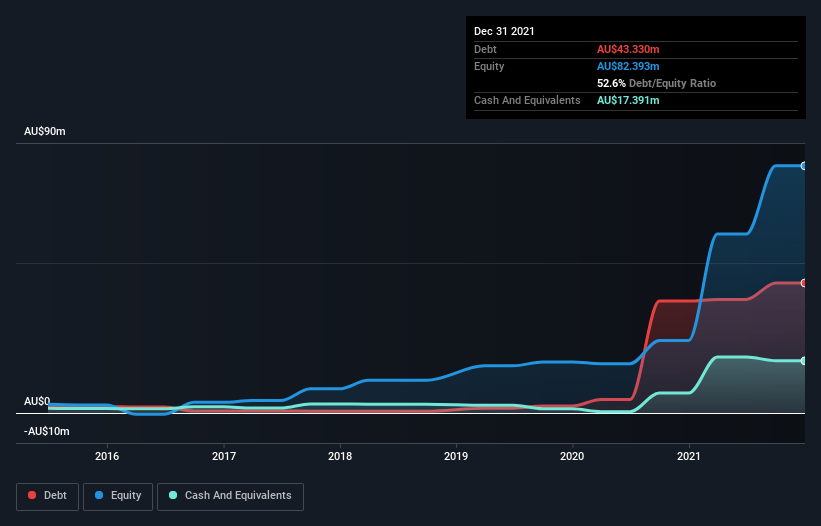The external fund manager backed by Berkshire Hathaway's Charlie Munger, Li Lu, makes no bones about it when he says 'The biggest investment risk is not the volatility of prices, but whether you will suffer a permanent loss of capital.' So it might be obvious that you need to consider debt, when you think about how risky any given stock is, because too much debt can sink a company. As with many other companies Allegiance Coal Limited (ASX:AHQ) makes use of debt. But is this debt a concern to shareholders?
Why Does Debt Bring Risk?
Debt assists a business until the business has trouble paying it off, either with new capital or with free cash flow. Part and parcel of capitalism is the process of 'creative destruction' where failed businesses are mercilessly liquidated by their bankers. While that is not too common, we often do see indebted companies permanently diluting shareholders because lenders force them to raise capital at a distressed price. Having said that, the most common situation is where a company manages its debt reasonably well - and to its own advantage. When we think about a company's use of debt, we first look at cash and debt together.
Check out our latest analysis for Allegiance Coal
What Is Allegiance Coal's Net Debt?
You can click the graphic below for the historical numbers, but it shows that as of December 2021 Allegiance Coal had AU$43.3m of debt, an increase on AU$37.3m, over one year. However, it does have AU$17.4m in cash offsetting this, leading to net debt of about AU$25.9m.

How Healthy Is Allegiance Coal's Balance Sheet?
According to the last reported balance sheet, Allegiance Coal had liabilities of AU$27.8m due within 12 months, and liabilities of AU$52.4m due beyond 12 months. Offsetting these obligations, it had cash of AU$17.4m as well as receivables valued at AU$321.9k due within 12 months. So its liabilities total AU$62.5m more than the combination of its cash and short-term receivables.
Allegiance Coal has a market capitalization of AU$212.5m, so it could very likely raise cash to ameliorate its balance sheet, if the need arose. However, it is still worthwhile taking a close look at its ability to pay off debt. When analysing debt levels, the balance sheet is the obvious place to start. But you can't view debt in total isolation; since Allegiance Coal will need earnings to service that debt. So when considering debt, it's definitely worth looking at the earnings trend. Click here for an interactive snapshot.
In the last year Allegiance Coal wasn't profitable at an EBIT level, but managed to grow its revenue by 480,310%, to AU$13m. When it comes to revenue growth, that's like nailing the game winning 3-pointer!
Caveat Emptor
Despite the top line growth, Allegiance Coal still had an earnings before interest and tax (EBIT) loss over the last year. Its EBIT loss was a whopping AU$41m. When we look at that and recall the liabilities on its balance sheet, relative to cash, it seems unwise to us for the company to have any debt. So we think its balance sheet is a little strained, though not beyond repair. Another cause for caution is that is bled AU$77m in negative free cash flow over the last twelve months. So suffice it to say we consider the stock very risky. When analysing debt levels, the balance sheet is the obvious place to start. But ultimately, every company can contain risks that exist outside of the balance sheet. We've identified 3 warning signs with Allegiance Coal , and understanding them should be part of your investment process.
If, after all that, you're more interested in a fast growing company with a rock-solid balance sheet, then check out our list of net cash growth stocks without delay.
New: Manage All Your Stock Portfolios in One Place
We've created the ultimate portfolio companion for stock investors, and it's free.
• Connect an unlimited number of Portfolios and see your total in one currency
• Be alerted to new Warning Signs or Risks via email or mobile
• Track the Fair Value of your stocks
Have feedback on this article? Concerned about the content? Get in touch with us directly. Alternatively, email editorial-team (at) simplywallst.com.
This article by Simply Wall St is general in nature. We provide commentary based on historical data and analyst forecasts only using an unbiased methodology and our articles are not intended to be financial advice. It does not constitute a recommendation to buy or sell any stock, and does not take account of your objectives, or your financial situation. We aim to bring you long-term focused analysis driven by fundamental data. Note that our analysis may not factor in the latest price-sensitive company announcements or qualitative material. Simply Wall St has no position in any stocks mentioned.
About ASX:AHQ
Allegiance Coal
Allegiance Coal Limited, together with its subsidiaries, engages in the acquisition, exploration, and development of coal tenements.
Slightly overvalued with weak fundamentals.
Market Insights
Community Narratives



